When it comes to foraging for morels, this fungi is deservedly one of the most highly regarded and prized and this is why we always get excited when Morel season comes around again each spring.
They’re so expensive because it’s very difficult to cultivate them – Scientists have been trying for decades to come up with a reliable method to imitate the precise conditions that the fungus needs to grow in the wild. So at time of writing, the morels you could buy at a market or at a restaurant have been handpicked by foragers, and that takes time and know-how.
These elusive fungi are also fussy about habitat and relatively scarce in the UK, so most on the market are imported. To find a few closer to home is a real treat! Once cooked correctly a gorgeous delicacy with a really rich, meaty flavour and texture. Some chefs will blanch them first before proceeding to treat them like any other mushroom, or you could include them in a dish with a longer cooking time such as a risotto, and get great results. Scroll to the end for a few ideas – but first – here’s how to tell the different species apart from poisonous lookalikes.
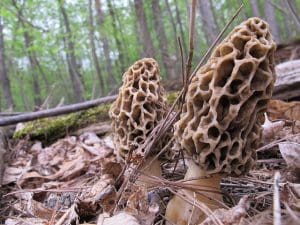
Health Warnings When Foraging for Morels
All morels are toxic raw, known to cause gastric upsets in some people and containing hemolysins which can damage red blood cells. Hemolysins are broken down by heat however, so after being cooked for 20 minutes they become safe.
Very rarely, cases arise of temporarily neurological symptoms cerebellar syndrome after eating morels – described as being similar to drunkenness and occurring 12 hour onwards from consumption. Here is a review of what is known about it
Basically, the precise toxin responsible remains unclear, but there seems to be a link to
1) consuming a very large amount of fresh morels (rather than dried and rehydrated)
2) morels picked near a stream
3) morels picked under Ash trees
4) morels that were in bad condition and possibly contaminated.
Symptoms are not fatal and usually resolve within a few days, but its worth being aware that its a thing and to seek medical help if you feel unwell, just like with any bad reaction to food.
Identification of Wild Morel Mushrooms
Morels typically appear in the spring, and tend to prefer sandy soils or recently laid woodchip. Being brown on a brown background they are harder to spot than other mushrooms, you may have to spend some time getting your eye in.
The first thing that will catch your eye is a white stem with a brown, heavily textured blob on top – there are no gills or pores like your more typical umbrella-shaped mushroom.
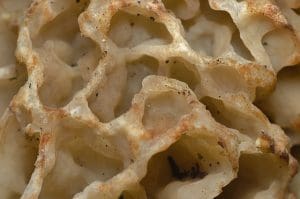
The most important feature to look for when distinguishing a morel from one of its poisonous lookalikes is to look closely at the cap and see if it has irregular, deep, honeycomb-like pits all over. Lookalikes may have wrinkles and folds, but not these pits with clear edges dividing one from another. Next, slice it in half, and check that the stem and cap are completely hollow.
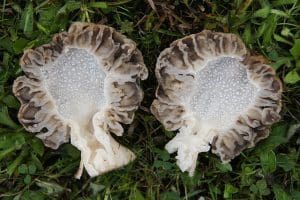
The 3 Most Common Morel Mushrooms in the UK
Here are the three species you are most likely to see in the UK – click on the name to go straight to our more detailed ID guides
Golden Morels
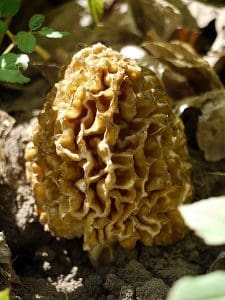
Golden morel (Morchella esculenta) looks like a pitted Golden yellow blob on a white stem, found on waste ground, woodland, sometimes it’s even found in gardens.
Common Morels
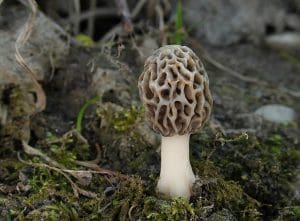
Common Morel (Morchella vulgaris) pretty similar to golden morel, found on waste ground and in sand dunes
Black Morels
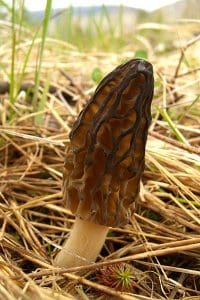
Black Morel (Morchella elata) the cap is darker and more conical than the Golden or Common morels. Seems to like coniferous woodland, burned ground, and woodchip
Wild Morel Mushroom Lookalikes
Now on to the Lookalikes you need to avoid when we’re out foraging for morels –
Flase Morels
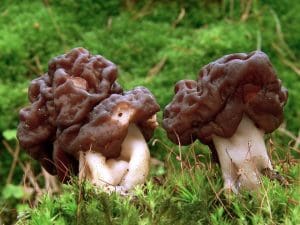
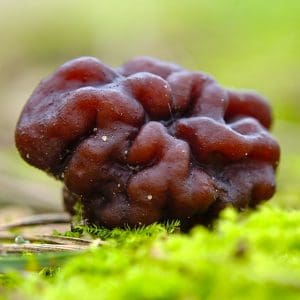
False morel Gyromitra esculenta Beware of this one, it is deadly poisonous! The brown blob on top of the stem is wrinkled like a brain, not pitted like a real morel.
Thimble Morels
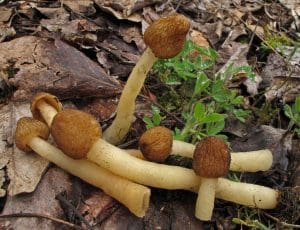
Thimble morel Verpa conica. The small bell shape cap is free from the stem, as if balanced on top. Its fairly unusual in the UK, growing with Hawthorn on chalky soils. But as its toxic, definitely one to be aware of and rule out of your cooking.
Stinkhorn Mushrooms
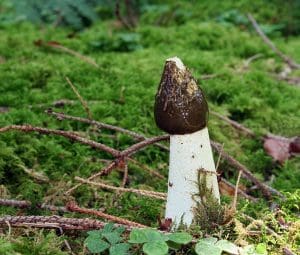
Stinkhorn Phallus impudicus This might superficially look like an unusually tall stemmed morel, but the slime and the horrible stink of rotting meat should put you off before you get anywhere near tasting it! A mistake might be easier to make on older specimens, when the slimy stinky grey matter has washed off or been eaten by flies already – what remains can look a little bit honeycombed like a morel. The different will be in the stem – stinkhorn stems are longer, have a texture a bit like expanded polystyrene, and aren’t hollow like a real morel.
Recipe ideas for Cooking with Morel Mushrooms
The rich, meaty, earthy flavour makes them a great addition to vegetarian and vegan dishes, though of course you can use them alongside meat and fish too. Just always remember to cook them for at least 20 minutes, blanching them in boiling water first if necessary.
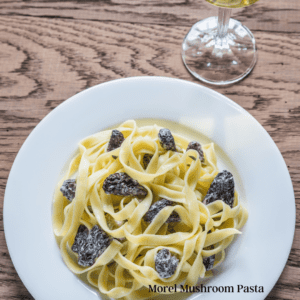
- Simply sauteed in butter and salt, they are a divine side dish
- Battered and deep fried, try them with a lemony dipping sauce like calamari
- Add them to any creamy pasta sauce – add a few fresh green vegetables such as peas or asparagus for colour and to compliment the earthy flavour
- Stuffed Morels, because of the hollow stem, they can be stuffed and baked into tasty morsels – its fiddly because of the small size, but makes a divine show piece.
Through this piece on Foraging for Morel Mushrooms I really hope I’ve been able to make you feel much more confident in finding & safely identifying wild edible morel mushrooms.
We’ve taken a look at the most common types of morels we find here in the UK aswell as the potential lookalikes you may accidentally confuse morel mushrooms for.
Lastly we’ve covered some cooking tips and ideas for cooking up your foraged morels!
As always Happy Foraging and good luck on your mushroom hunt.





